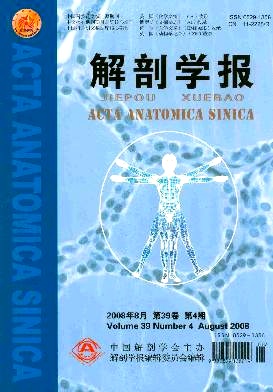|
|
THE EXPRESSION OF NF-κB p50 AND THE EFFECT OF SAIKOSIDE a IN THE PROCESS OF HUMAN PERIPHERAL BLOOD MONOCYTE DIFFERENTIATING INTO DENDRITIC CELLS
2007, 38 (6):
681-686.
doi:
Objective To observe the expression of NF-κB p50 protein in the process of the human peripheral blood monocytes differentiating and maturing into dendritic cells. Methods Human peripheral blood monocytes were obtained by discontinuous density gradient centrifuged method. Monocytes of different groups (cytokine group, saikoside group, co\|culture group)were cultured with different stimulating factors such as GM\|CSF, IL-4, TNF-α and saikoside in vitro. The inverted phase contrast microscope, Wright’s staining, immunocytochemical staining were used respectively to observe the changes of morphology, surface differentiation antigen including CD14, CD83, HLA\|DR,S\|100, and the expression of intracellular transcription factor NF-κB p50 protein, in the process of monocytes differentiating into dendritic cells. The image analysis and SPSS software were used to analyze the results. Results The obtained monocytes and dendritic cells possessed their respective cell shape and cell surface antigen marker by cell morphology observation and cell surface marker immunocytochemical staining such as CD14, HLA\|DR, S\|100 and CD83. The monocytes differentiated into immateure dendritic cells(imDC) when cultured with RPMI\|1640 medium containing GM-CSF and IL-4 for 7 days. The imDC differentiatd into mature dendritic cells (mDC) when cultured with RPMI\|1640 medium containing GM\|CSF,IL\|4 and TNFα for another 3 days. The expresion of NF-κB p50 in the two cells showed a significant difference (P<0.05). When Monocytes were cultured with RPMI\|1640 medium containing saikoside a only for 7 days, NF-κB p50 staining in their nucleus was brown\|yellow, but differentiated imDCs was not found. As monocytes were cultured with RPMI\|1640 medium containing GM\|CSF,IL\|4 and saikoside for 7 days, the cells were identified as imDCs by immunocytochemical staining. Then the maturation promoting factor TNF\|α was added, cultured imDC for another 3 days, the nucleus appeared obvious NF-κB p50 brown\|yellow staining which was stronger than that of cytokine group. These cells were identified as mDC. The surface marker expression of co\|culture group stronger than that in cytokine group.Conclusion NF-κB p50 quantity increased in the nucleus when monocytes differentiated into imDC and mDC low concentration of
Related Articles |
Metrics
|


